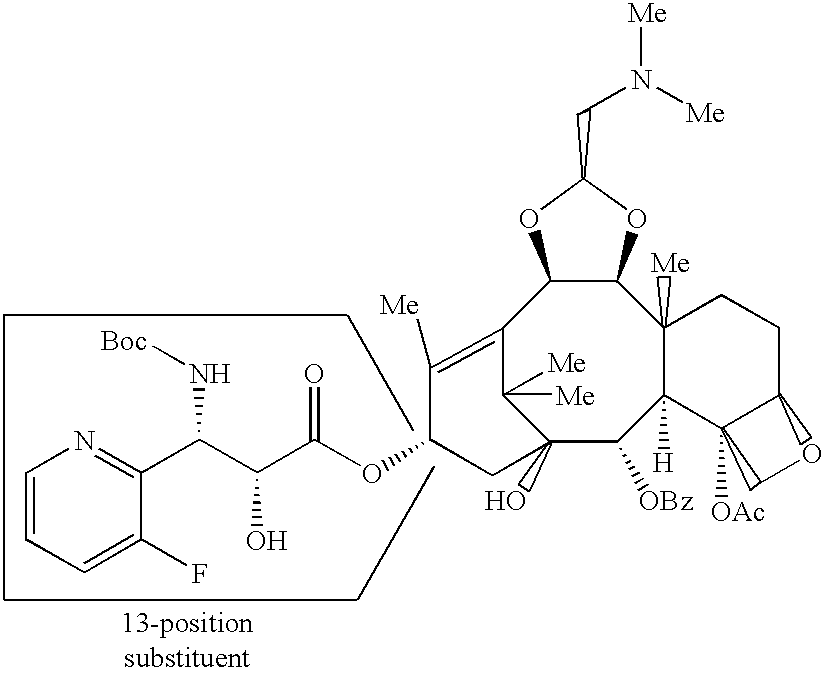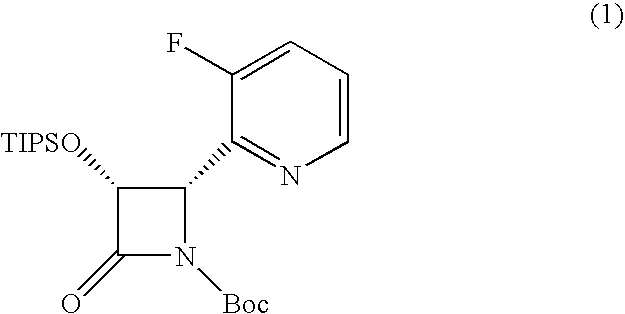Method for producing 2-azetidinone derivative
a technology of azetidinone and azetidinone, which is applied in the field of process for producing a 2-azetidinone derivative, can solve the problems of increasing the cost in case of mass production and low yield, and achieves the effect of low cost and efficient production in a large amoun
- Summary
- Abstract
- Description
- Claims
- Application Information
AI Technical Summary
Benefits of technology
Problems solved by technology
Method used
Image
Examples
example 1
(3R, 4S)-cis-3-acetoxy-4-(3-fluoro-2-pyridyl)-1-(4-methoxyphenyl)-2-azetidinone
[0065]Cis-3-acetoxy-4-(3-fluoro-2-pyridyl)-1-(4-methoxyphenyl)-2-azetidinone (480 g) was suspended in a mixture of ethanol (5.76 l) with 0.1 M phosphate buffer pH 7.0 (3.84 l). Then an enzyme Lipase PS-CI (144 g) was added thereto and the mixture was stirred at 25° C. for 16 hours. After evaporating ethanol, the residue was extracted with methylene chloride and the organic layer was evaporated. To the obtained residue were added methanol (8.16 l) and water (9.18 l) and the mixture was stirred at 10° C. for 16 hours. The crystals thus precipitated were collected by filtration and dried under reduced pressure to thereby give the title compound (182 g, 99.7% ee) as pale brown crystals.
[0066]1H-NMR (CDCl3) δ: 1.80 (s, 3H), 3.74 (s, 3H), 5.72 (d, 1H, J=5.6 Hz), 6.09 (d, 1H, J=5.1 Hz), 6.77–6.83 (m, 2H), 7.21–7.29 (m, 2H), 7.30–7.33 (m, 1H), 7.41–7.46 (m, 1H), 8.43–8.46 (m, 1H)
example 1a
(3R, 4S)-cis-3-acetoxy-4-(3-fluoro-2-pyridyl)-1-(4-methoxyphenyl)-2-azetidinone
[0067]Cis-3-acetoxy-4-(3-fluoro-2-pyridyl)-1-(4-methoxyphenyl)-2-azetidinone (1 g) was suspended in a mixture of ethanol (6 ml) with 0.1 M phosphate buffer pH 7.0 (4 ml). Then an enzyme Lipase PS-CI (1 g) was added thereto and the mixture was stirred at 25° C. for 30 minutes. After evaporating ethanol, the residue was extracted with methylene chloride and the organic layer was evaporated. To the obtained residue were added methanol (17 ml) and water (19 ml) and the mixture was stirred at 10° C. for 16 hours. The crystals thus precipitated were collected by filtration and dried under reduced pressure to thereby give the title compound (400 mg, 99.9% ee) as pale brown crystals. The 1H-NMR data of this product was identical with those of the compound obtained in Example 1.
examples 2 to 14
[0068]Reactions were carried out as in Example 1 but employing different enzymes and reaction solvents in the asymmetric hydrolysis reaction.
[0069]
TABLE 1Optical Purity ofReaction SolventCompound (III)ReactionEx. Enzyme(water content: 5%)(% ee)Ratio2Amanotoluene>95>48PS3Amanoisopropyl ether9242PS4Amanoethyl acetate>95>48PS-CI5Amanotoluene>95>48PS-CI6Amanoethanol>95>48PS-CI7Amanoacetonitrile>9536PS-CI8Amanoisopropyl ether9332PS-CI9Amanotetrahydrofuran>9537PS-CI10Amanoacetone9329PS-CI11Amanotoluene9326PS-DI12Amanoethanol9322PS-DI13Amanoisopropyl ether9128PS-DI14Amanoisopropyl ether9135AK
PUM
| Property | Measurement | Unit |
|---|---|---|
| optical purity | aaaaa | aaaaa |
| optical purity | aaaaa | aaaaa |
| optical purity | aaaaa | aaaaa |
Abstract
Description
Claims
Application Information
 Login to View More
Login to View More - R&D
- Intellectual Property
- Life Sciences
- Materials
- Tech Scout
- Unparalleled Data Quality
- Higher Quality Content
- 60% Fewer Hallucinations
Browse by: Latest US Patents, China's latest patents, Technical Efficacy Thesaurus, Application Domain, Technology Topic, Popular Technical Reports.
© 2025 PatSnap. All rights reserved.Legal|Privacy policy|Modern Slavery Act Transparency Statement|Sitemap|About US| Contact US: help@patsnap.com



